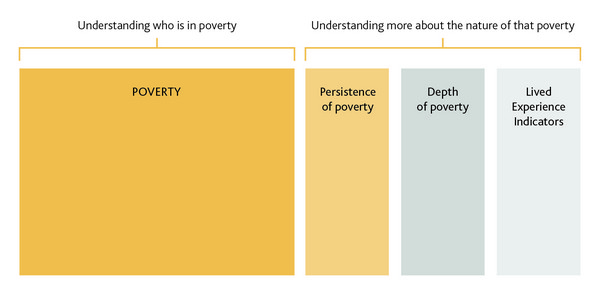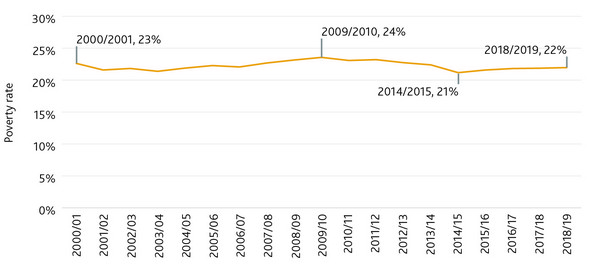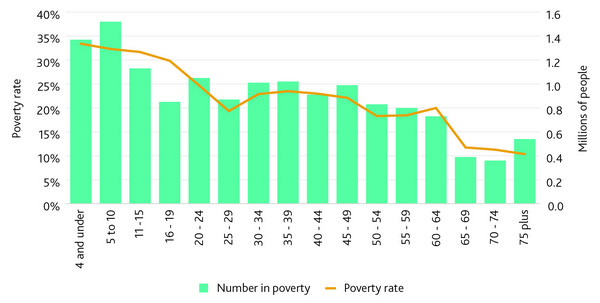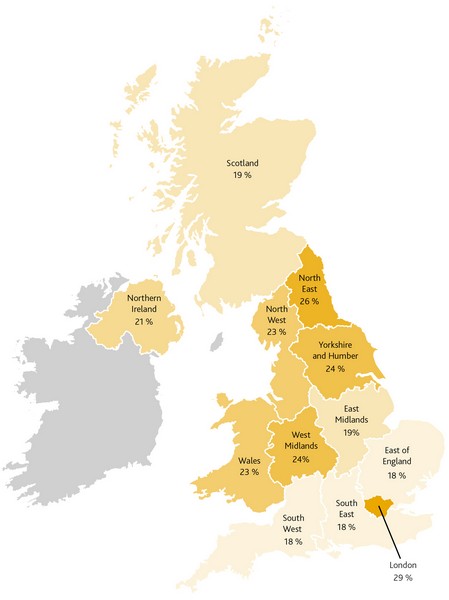About the research
At the time of writing, the UK has no official measure of poverty. As a result, there is no effective way to track the progress of efforts to tackle the causes of poverty, reduce poverty, or improve the lives of those experiencing poverty. In addition, policymakers and politicians cannot be effectively held to account for decisions and measures in this area.
The Social Metrics Commission was founded in 2016 to develop a new approach to poverty measurement for the UK. In response to the absence of an official measure, its ambition was to develop metrics that both better reflected the nature and experiences of poverty that different families in the UK have, and could be used to build a consensus around poverty measurement and action in the UK.
Formed and led by the Legatum Institute’s CEO Baroness Stroud, the Commission is totally independent, drawing members from across the political spectrum and with various relevant backgrounds. A list of our 15 Commissioners can be found here.
In September 2018, we produced our first report, which set out how the approach to poverty measurement could be improved in the UK and elsewhere. The Commission’s 2018 report was the first time this framework had been used to present a detailed articulation of the nature of poverty in the UK. Using data from the Family Resources Survey, Households Below Average Income and Understanding Society to operationalise the measure, our findings suggested that the same number of people were in poverty in the UK as previously thought. However, within this overall population, the Commission’s results suggested significant changes to the groups identified as being in poverty and also shed greater light on the depth, persistence, and Lived Experiences of poverty.
We have since published two annual reports, in July 2019 and July 2020, which included the latest available data as well as methodological updates. In December 2019, we also published a report laying out a framework for how more accurate equivalisation scales could be developed. Most recently, in August 2020, we released a report detailing the likely scale and nature of poverty impacts coming from the economic fallout of the Covid-19 pandemic in the UK.
A major impact of the Commission’s work has been the Government’s commitment to developing an Experimental Statistic based on the Commission’s measurement framework. Following the Government’s announcement in May 2019, our team has continued to support the Department for Work and Pensions’ work to develop these statistics. Developing a new Experimental Statistic would be a major step towards the Commission’s ultimate goal of the development of new official poverty statistics in the UK, which can be used to guide and prompt policy action.
Research funding and partners
The Commission is hosted by the Legatum Institute, which makes available the resource of its Centre for Metrics, and is supported by the Legatum Institute Foundation. The Commission’s work would not be possible without that support, and the research, editorial and functional independence that has underpinned it. Throughout the duration of it’s work, the Commission has also been generously supported by the Joseph Rowntree Foundation, Calouste Gulbenkian Foundation (UK Branch), Garfield Weston Foundation, Oliver Wyman, Jon Moulton, Stuart Roden, the PF Charitable Trust and Mr Sanjit and Mrs Sangeeta Talukdar.
Methodology
The Commission’s Measurement Framework
The Commission’s poverty metrics include a core measure of poverty, as well as broader measures on the depth, persistence, and Lived Experiences of poverty.
The core measure looks at the extent to which the material resources that someone has available to them now are sufficient to meet the material needs that they currently have. Operationalising this allows us to understand how many people are in poverty and who they are.
As well as measuring the incidence of poverty, Commissioners developed a broader measurement framework that provides deeper understanding into the nature of poverty, looking at factors that affect the experience of poverty, influence the future likelihood of poverty, or are consequences that flow from being in poverty. The figure below demonstrates that, alongside measuring the number of people in poverty, we also report on the depth of poverty, the persistence of poverty, and the Lived Experience of those in poverty.
You can find the full details of our methodology in our 2018 report.

Figure 1: Elements of the Commission’s Measurement Framework
Larger version Figure 1 | Explanatory text
How is our poverty measure different?
The Commission’s measure includes improvements in three key areas:
- Identifying those least able to make ends meet. The Commission’s measure:
- Accounted for all material resources, not just incomes. For instance, this meant including an assessment of the available liquid assets that families have.
- Accounted for the inescapable costs that some families face, which make them more likely than others to experience poverty. These include the extra costs of disability, costs of childcare, and rental and mortgage costs.
- Broadened the approach of poverty measurement to include an assessment of overcrowding in housing and those sleeping rough.
- Providing a better understanding of the nature of poverty, by presenting detailed analysis of poverty depth and persistence for those in poverty.
- Providing an assessment of Lived Experience Indicators that shine a light on the differences in experiences of those living in poverty and those above the poverty line.
Data used from the UK Data Service collection
Family Resources Survey, 2018-2019
Households Below Average Income, 1994/95- 2018/19
Findings
Our latest report, Measuring Poverty 2020, finds that:
- Poverty in the UK remains a significant issue. 14.4 million people in the UK are living in families in poverty. 4.5 million of these are children (33% of all children), 8.5 million are working-age adults (22% of all working-age adults), and 1.3 million are pension-age adults (11% of all pension-age adults).
- Overall rates of poverty have changed relatively little since the millennium. The current rate of poverty is 22%, which is the same as last year and only slightly lower than the 23% seen in 2000/01 (the first available year of results using the Commission’s approach).

Figure 2: UK poverty rate since 2000/01
Larger version Figure 2 | Data from figure 2 in accessible format
- Poverty rates for a number of groups have fallen since 2000/01. Poverty rates for people in lone-parent families have fallen from 62% to 48% and for pension-age adults from 18% to 11%. And while recent years had shown rates for some groups begin to rise again, this year’s data shows this trend plateau or reverse.
- The older you are, the less likely you are to be in poverty. 33% of children aged four and under are in poverty, compared to 23% of those aged between 40 and 44 and 10% of those aged 75 and over.

Figure 3: Poverty rates and number in poverty for the UK population, by age group (2018/19)
Larger version Figure 3 | Data from figure 3 in accessible format
- Deep poverty has increased in the last two decades.5 million people (7% of the population) in the UK now live in the deepest form of poverty (more than 50% below the poverty line), compared to 2.8 million people (5% of the population) in 2000/01.
- This means that the incidence of deep poverty has increased by 39% and that 1.3 million more people experience deep poverty today than would have been the case had the incidence of deep poverty still been at the level seen in 2000/01.
- Persistent poverty is largely unchanged.1 million people (11% of the population) in the UK live in persistent poverty, meaning that they are in poverty today and were also in poverty for at least two of the last three years.
- Poverty rates vary significantly between English regions. They are highest in London (29%), North East (26%), Yorkshire and Humber (24%) and the West Midlands (24%). Regions with the lowest rates are the South West, South East, and East of England (all 18%) and the East Midlands (19%).
- Poverty rates vary less across the UK’s four nations. The highest rates are in Wales (23%) and the lowest in Scotland (19%).

Figure 4: Poverty rates for the UK population, by English region, 2018/19
Larger version Figure 4 | Data from figure 4 in accessible format
The Commission’s Lived Experience Indicators show that those in poverty experience worse outcomes than those not in poverty:
- One in five people (20%) in poverty lives in families where no one has any formal qualifications, compared to less than one in ten (8%) of those in families not in poverty.
- Nearly three in ten people (27%) in poverty live in a family that is behind with paying bills, compared to less than one in ten (7%) of those not in poverty. The majority of people in poverty (70%) live in families where no-one saves. For those not in poverty, this stands at 38%.
- Recent years have seen a closing of the gap between those in poverty and those not in poverty for some of the Lived Experience Indicators. Fewer people in poverty are living in families where someone feels unsafe walking alone at night (down by six percentage points since 2011/12) or where someone worries about being affected by crime (down four percentage points since 2011/12).
- The proportion of people in poverty who live either in lone-parent or single pensioner families has fallen. For example, since 2000/01 the proportion of people in poverty who live in lone-parent families has fallen by eight percentage points
Downloads of the results tables containing summary data for the figures that appear in each of our reports are available in Excel and PDF formats:
The Commission also makes its code freely available, with the aim that others will build upon its work.
Findings for policy
Measuring poverty is vital if action is going to be taken to improve the lives of those currently living in, or at risk of falling into, poverty. It is also essential to ensuring that those individuals, families, communities, and areas of the UK that have historically been left behind are supported to improve their situation. In addition, as the full extent of the Covid-19 crisis unfolds, measuring poverty will be central to ensuring that the long-term economic and social impacts of the crisis are tackled. To that end, the Commission believes that, with existing data and research, the approach we have developed represents the most accurate measure of poverty, which is also most likely to build consensus and drive action on poverty.
However, the Commission also recognises that creating a new measure of poverty is only the start of what needs to happen. We will continue to support efforts to develop a new Experimental Statistic based on the Commission’s approach, as well as shining a light on areas that still warrant further exploration. The Commission has already outlined the steps needed to develop a new approach to equivalisation in the UK, and will continue to argue for improved survey and administrative data (including on debt and the costs of social care). We will also work to support the development of a more comprehensive approach to capturing the extra costs of disability.
In taking this work forward, the Commission will work with the widest range of stakeholders possible to ensure that, once fully developed, the Experimental Statistic can form the basis of a consensus view on poverty measurement across the UK Government, the Opposition, the Office for National Statistics, policymakers, and those researching and working with people in poverty. Without this, a large part of society risks being left further behind without the support that they need to improve their lives.
Impact
Since the Commission’s work began in 2016, our ultimate goal has been to develop new poverty metrics for the UK which both have long-term political support and effectively identify those who are in poverty. In a field of policy and politics that is divisive and that has seen little change of practice or approach in the last two decades, in the space of just four years the nature of the debate has fundamentally shifted.
Our work has been welcomed by commentators and politicians from across the political spectrum as well as the poverty lobby, experts and researchers, and we have undertaken significant engagement across the UK’s four nations, with parliamentarians, experts, officials, poverty experts and academics.
UK Government
In November 2018, the UN Special Rapporteur on extreme poverty and human rights, Professor Philip Alston, in a Statement on his visit to the United Kingdom, encouraged the UK Government to adopt the Social Metrics Commission’s poverty measure, saying:
“The bipartisan Social Metrics Commission’s New Poverty Measure represents an attempt to create a single comprehensive measure of poverty, and these are the numbers I reference here unless otherwise noted. I would urge the Government to respond to the Commission and adopt its approach, which has received an impressive degree of cross-party support.”
In January 2019, the House of Lords debated the Commission’s poverty measure (video); the House also asked the Government what assessment they had made of the Commission’s poverty measure. In the same month, the Commission presented evidence to the Work and Pensions Select Committee (video).
In February 2019 the All Party Parliamentary Group on Statistics, in conjunction with the Royal Statistical Society, held a meeting to discuss the new poverty measure developed by the Social Metrics Commission.
In May 2019, the DWP announced that it would create Experimental Statistics in 2020 based on the Commission’s poverty measure.
In June 2019, the House of Lord’s debate on inequalities included references to the importance of the measure developed by the Commission.
In July 2019, the Work and Pensions Select Committee published its report on the welfare safety net, recommending that the Government adopt the Commission’s approach as its “…official, central measure of poverty”.
Tynwald: the Isle of Man’s Government
In July 2019, the Commission presented evidence to the Select Committee on Poverty for Tynwald, the Parliament of the Isle of Man. The Select Committee compared the Commission’s measure with 10 other approaches to measuring poverty and found it to be the closest fit with their requirements for understanding poverty. Consequently, its First Report: Poverty Definitions & Data 2019-2020 recommended that the Isle of Man Government adopt and measure the Commission’s measure. These recommendations were subsequently passed by the Tynwald.
States of Jersey: States Assembly
A question was raised as to whether the States of Jersey would be adopting a measure of poverty based on the Commission’s work to be comparable with the planned UK Department for Work and Pensions Experimental Statistics.
Research building on the Commission’s poverty measure
Policy in Practice, in its report Financial Resilience and the Transition To Universal Credit, devised an indicator called ‘Income After Costs’ to determine financial vulnerability, which is based on the Commission’s measure.
Reports by organisations referencing the Commission’s poverty measure
The IFS: Living standards, poverty and inequality in the UK: 2019
The Trussell Trust: Introduction to a Study of Poverty and Food Insecurity in the UK
Joseph Rowntree Foundation: UK Poverty, 2019/20
Green New Deal Group: The Green New Deal – A Bill to make it happen
Full fact: Poverty in the UK: a guide to the facts and figures
Examples of high-profile media coverage
The Independent: What is this new UK poverty measure and what was wrong with the old one?
The Guardian: More than 4m in UK are trapped in deep poverty, study finds and Nearly half of BAME UK households are living in poverty
Daily Mail: 4.5 million people in `deep poverty´ in UK
Metro: 14,300,000 people in Britain are living in poverty
Financial Times: Johnson urged to help 7m people on persistently low incomes
Full Fact: Poverty in the UK: a guide to the facts and figures and We all deserve a better debate on poverty
ConservativeHome: Coronavirus has hit those in poverty hardest. The Government must support employment, fast.
The Social Metrics Commission website also records responses from the community to the development of the poverty measure and its latest report.
Publications
A new measure of poverty for the UK (2018 report)
